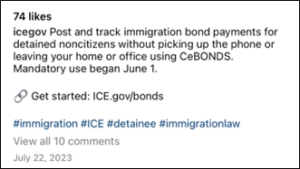Written by Raul Pinto & Laila Khan
Approximately one year ago, U.S. Immigration and Customs Enforcement (ICE) launched Cash Electronic Bonds (CeBONDS), a web portal with the stated intent improving how people pay bonds to ICE to secure the release of a loved one from detention. One year in, it’s clear that while CeBONDS makes it easier for some to pay bonds, it presents serious complications for others.
What is CeBONDS?
CeBONDS is a web-based system that allows individuals paying a bond, known as the obligors, to enter information into a portal and make bond payments to ICE at a local bank using electronic fund transfers ACH and FedWire. Before CeBONDS, obligors paid bonds in person at ICE field offices, which then instructed the detention facilities to arrange for the release of the noncitizens who posted the bonds.
In June 2022, prior to ICE’s announcement that it would implement CeBONDS, the American Immigration Council, the Immigrant Legal Defense, and several other groups filed a request under the Freedom of Information Act (FOIA) to find out more about bond procedures in general. The groups made the request in response to complaints from community groups who experienced inconsistent ICE policies when paying bonds that often resulted in delayed releases.
After more than a year of litigation, the lawsuit prompted ICE to disclose certain agency guidance about bond payment on its website. Once ICE announced the shift to CeBONDS, the groups moved to obtain information about the transition.
ICE Shifts to CeBONDS
As the agency prepared to implement CeBONDS in 2023, ICE communicated to the public that it would completely shift its bond payment operation to the CeBONDS portal. One of the documents uncovered by the FOIA request revealed that the agency planned to mislead the public about the availability of walk-in bond payments. ICE announced that it would transition to CeBONDS on June 1, but an internal May 30, 2023 memo shows ICE moved that deadline to July 1. The agency did not want to broadcast this move to the public to “encourage the use and transition to CeBONDS.”

Source: Update to Cash Electronic Bonds (CeBONDS)Transition Period
As late as July 22, ICE continued to insist that the use of CeBONDS was “mandatory” on its social media platforms.
Social media posts also mischaracterized the CeBONDS payment process. Obligors using CeBONDS must post their payment at a bank; the payment cannot be made online.
Ambiguity and Inaccessibility Persist One Year Later
Currently, ICE’s website suggests that the use of CeBONDS is a requirement. The agency advises that there may be “operational exceptions to this requirement,” and that it will continue to work with obligors who want to pay bonds in-person on a case-by-case basis.
However, ICE’s website neither provides information as to what constitutes an “operational exception,” nor does it provide guidance as to the type of cases where walk-in payments are accepted. The agency merely encourages people to contact their local field office for guidance.
CeBONDS is not accessible to all obligors. Some rely on the walk-in option to get their loved ones out of detention. For example, CeBONDS requires obligors to upload proof of U.S. citizenship or Legal Permanent Resident status. Yet, ICE’s Bond Management Handbook, which ICE published on its FOIA Library as a result of our litigation, indicates that nonimmigrant visa holders, individuals under orders of supervision, and even people in removal proceedings can post a bond at the local field office. Congressional leaders have also expressed concern that people without bank accounts may not be able to access CeBONDS.
The case of M. Kane highlights the dangers of online-only bond payments. The Kane family experienced several roadblocks when they attempted pay a bond through CeBONDS portal twice prior to their October 15, 2023 deadline. It took the family more than a month to navigate through the issues and secure the release of their loved one, only after posting the bond in person.
The modernization of the bond payment system is a worthwhile endeavor. In many cases, obligors drove hundreds of miles to local ICE field offices to often have their payments rejected, or find the facilities closed. A system that allows people to pay bonds to ICE at their local banks undoubtedly makes payment easier, and therefore the release of individuals in detention faster. However, the online-only system presents new obstacles for detained individuals and their families, which in some cases can lengthen detention times when these barriers can’t be quickly addressed.
In addition, despite purported plans to expand the use of CeBONDS, ICE has failed to provide concrete measures for these efforts. On August 8, 2023, ICE announced it would use CeBONDS to send obligors certain notices relating to the bonds paid. However, the agency failed to provide a specific timeline for implementation of this notification system.
Failing to inform the public about the continued availability of walk-in payments and how the agency plans to expand the use of CeBONDS adds to the confusion around the payment process. The agency must be transparent with the public about when and how it accepts bond payments. Without the FOIA efforts, the agency’s tactic of keeping the public in the dark about the availability of walk-in payments would not have come to light.
Clear instructions are needed when people’s liberty is at stake, and ICE must do better.
FILED UNDER: Immigration and Customs Enforcement


